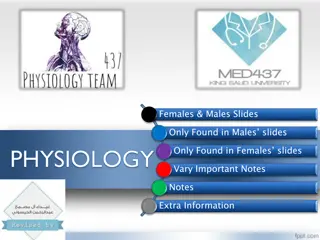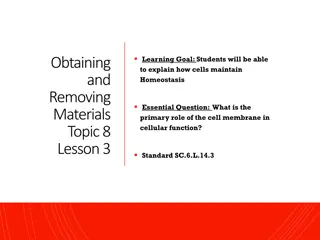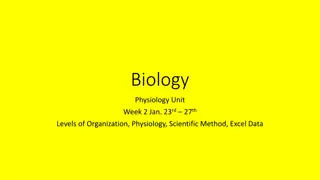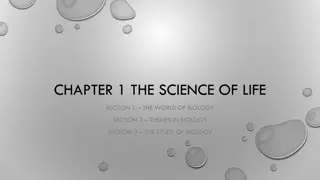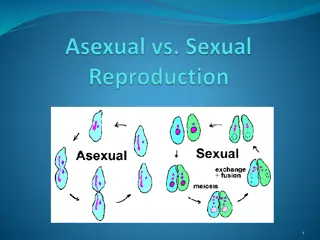Understanding Homeostasis in Living Organisms
Homeostasis, derived from Greek meaning "standing still", is crucial for maintaining balance in living organisms. It involves regulating internal variables to prevent disease or death. Ancient Greeks emphasized the importance of harmony and equilibrium in life. Claude Bernard and Walter B. Cannon further developed the concept, highlighting the necessity of balanced changes within organisms. From unicellular to multicellular life, all organisms require essential elements from their external environment to survive, emphasizing the critical nature of maintaining internal balance for optimal cellular function.
Download Presentation

Please find below an Image/Link to download the presentation.
The content on the website is provided AS IS for your information and personal use only. It may not be sold, licensed, or shared on other websites without obtaining consent from the author. Download presentation by click this link. If you encounter any issues during the download, it is possible that the publisher has removed the file from their server.
E N D
Presentation Transcript
Homeostasis Homeo = same Stasis = standing Greek for standing still
Homeostasis is the state of balance within our bodies Living organisms require a balance of certain variables within their bodies to stay alive. = Homeostasis is necessary for life. When homeostasis is disrupted and these variables become imbalanced, disease or death can occur.
A History of Homeostasis Ancient Greeks believed that harmony, balance, equilibrium, and a steady-state were all fundamental to life and death. They were right! Greek philosopher Heraclitus postulated that people are not fixed and unchanging but rather undergo constant change.
Claude Bernard theorized that achieving a balance of these changes within organisms is essential for life. Walter B. Cannon named this homeostasis and further theorized that it was a process of synchronized adjustments in the internal environment to normal ranges.
Unicellular to Multicellular From the unicellular amoeba to the 100 trillion cells in in the human body, all living things have basic needs. Humans need: Water - for many metabolic processes Food - to supply energy, raw materials & chemicals for vital reactions Oxygen- to release energy from food materials Heat- to promote chemical reactions Pressure- to allow breathing These materials are not found inside our bodies, and we must interact with our environments to get them. Without them we couldn t survive.
These amoeba take in nutrients & O2 from their external environment and eliminate wastes generated inside, like CO2,back out. All life requires these constant exchanges between their internal & external environments. Internal Environment: Everything inside the body External Environment: Everything outside the body Nutrients are brought in Wastes are eliminated out
Despite the constant exchanges between our internal & external environment and a constantly changing external environment, our internal environment must be kept balanced and stable so that our cells can perform their metabolic functions at maximum efficiency. This state of internal balance in our bodies is homeostasis.
The Homeostasis Fish Bowl To illustrate homeostasis, we will use a fish bowl metaphor where the fish bowl is the human body holding our living cells & the fish are the living cells inside our body. The fish bowl is the boundary between what is inside and what is out. Our internal environment is the water inside the fishbowl. Our external environment is everything outside the fish bowl. If you ve ever had a pet fish, you know it is very important that the water (internal environment) is maintained at certain levels. For example: there is an optimum temperature level, high oxygen and low carbon dioxide levels, low waste concentration, & plenty of food to feed the fish We use specific devices to help maintain each level- like a heater to maintain the temperature, an air pump to maintain the oxygen and carbon dioxide levels, and a filter to keep waste concentration low. In the human body, we also need to keep variables balanced at certain levels but we use organ systems instead of devices.
Variables in Hemostasis What are the variables we must regulate to maintain homeostasis? 1. pH The relative amount of acid in the body. The human body has a pH range of 6.8 7.8. An imbalance in pH would cause our cells to cease functioning and we would die. 2. Concentration of Nutrients Cells in our body need a constant supply of nutrients and energy. 3. O2 & CO2 Levels Cells need O2 to generate energy but this process also produces CO2 byproducts which must be removed. Too much CO2 would make our pH levels acidic. O = C = O O = O
Variables in Hemostasis 4. Temperature Cells also have an optimum temperature range. If cells are too cold, their processes slow down. If they get too hot, their proteins will lose their shape (denature) and stop working. 5. Water, Salts & Electrolyte Levels The concentration of salt in our internal environment regulates water levels in cells. This is important to maintain proper volume in cells or they will either shrivel up or burst. shrivel up normal burst Different electrolytes have different important functions e.g., potassium (K+) controls the rhythmic beating of the heart so we need a relatively constant concentration.
Variables in Hemostasis 6. Waste Removal Chemical reactions often produce byproducts called cellular waste that have a toxic effect on the body if they accumulate. 7. Volume & Pressure Our blood vessels deliver oxygen & nutrients to all the cells in our body. These vessels must have a certain volume & pressure to stay open and allow blood to flow through. Too little volume/pressure in blood vessels is called Hypotension and the body does not get enough blood. Too much volume/pressure in blood vessels is called Hypertension which can lead to heart attacks or stroke.
Maintaining Homeostasis Our cells perform their metabolic processes best at a certain level called set point the target level that a variable is regulated around to maintain homeostasis. The homeostatic variables listed (pH, temperature, etc.) all have set points in homeostasis. When these variables fall too low or too high from the set pointour cells may cease functioning.
Set Point For example: As our stomach digests and breaks down foodstuffs, the cells that line our intestine have proteins that bring these nutrients into the cell to be used. These proteins must transport the nutrients across the cell membrane to get into the cell. These proteins operate best at a pH set point If the pH deviates from this point, the proteins will not be able to carry nutrients effectively across the plasma membrane. Intestine lining cell Outside the cells Set Point Enzyme Activity Rate This is a photomicrograph of intestine lining cells What causes pH to deviate from the set point? A photomicrograph is a picture taken through a microscope pH Too low Too high
Threats to Hemostasis Threats to homeostasis are imbalances in any of the hemostatic variables. Walter B. Cannon theorized that these threats to homeostasis must come from the external environment. For instance we maintain our bodies temperature at 98.7 (our temperature set point). If you leave an air conditioned room for a hot, summer day in Texas of +100 , your body can t function at a temperature above the set point. So to balance the external heat threatening your internal environment s homeostasis, you produce sweat to cool down.
Threats to Hemostasis In the case of a bacterial infection, toxins released by the bacteria & our immune response to the bacteria can change our temperature s set point upward which raises our body s temperature. This is called pyrexia or fever. This raising of temperature is believed to be a defense mechanism to help our immune system better kill the bacteria. However, if the temperature becomes too high for too long, the proteins will be damaged (denature) and the cells may die.
Regulation of Homeostatic Variables Humans use organ systems to make sure our homeostatic variables (pH, temperature, etc.) are kept in balance. What is an organ system? Organ systems are made up of individual and separate organs that work together as as a unit. e.g., the Respiratory System Parts: nasal & oral cavity, pharynx, larynx, trachea, left & right lung, & diaphragm All these parts/organs work together as an system to exchange gas with air when breathing.
Organ Systems Parts & Function Organ System Parts Function 1. Nervous system & 2. Endocrine system - brain, spinal cord, nerves - all endocrine glands Sensory input and integration; command and control 3. Muscular system muscles Strength, balance, posture, movement & heat 4. Skeletal system skeleton Support, movement & protect organs 5. Cardiovascular system heart, blood vessels & blood Transports nutrients between all tissues, organs and environmental interfaces 6. Gastrointestinal system (digestive system) esophagus, stomach, liver, pancreas, gallbladder, intestines, & colon Digestion of food and absorption of nutrients 7. Respiratory system nasal & oral cavity, pharynx, larynx, esophagus, trachea, left & right lung, & diaphragm Regulation of blood gases and exchange of gas with the air 8. Renal system kidneys, ureters, urethra, & bladder Regulation of volume and composition of body fluids 9. Integumentary system (skin) skin, hair & nails Protection from microbial invasion and water vapor barrier 10. Reproductive system reproductive organs Pass life on to the next generation 11. Immune system spleen, lymph nodes, bone marrow, & thymus Removal of microbes and other foreign materials
Organ Systems Quiz Identify each organ system based on what you know about its function.
Variables Regulation To keep the hemostatic variables balanced we have control centers that 1) detect imbalances, 2) coordinate correcting responses and 3) bring the variable back to the set point. Variable Effector produces the response needed to balance out the variable s deviation. Sensor detects changes in the variable either above or below the set point. Effector Sensor Integrator Integrator receives information from the sensor & coordinates a correcting response for the effector that will bring the variable back to set point.
Temperature Regulation Temperature of our bodies Temperature of a house Room Body Nerve receptors in our skin detect when Thermometers detect changes in temperature acting as the sensor temperatures fall above or below 98.7 as our sensors Muscles will produce quick flexing responses known as shivering to generate heat and balance our body temperature Temperature Temperature Heaters will produce the effect that brings the temperature back up acting as the effector back to normal as the effector Nerve Heater Muscles Thermometer Receptors Thermostat Brain Thermostats receive the thermostat s readings and decide if the temperature should be raised or lowered to maintain the temperature acting as the integrator 98.7 as our integrator Our Brain receive signals from our nerve receptors and coordinate the response needed to bring our temperature back to Analogy Video
Control Centers Control centers regulate variables to maintain homeostasis. There are two main control centers in our bodies: The Nervous System & the Endocrine system These systems are important to homeostasis because they determine & maintain the variables set point. They receive signals from their sensors about imbalances and send out corrective signals to their effectors (organ systems) to balance out any threats to homeostasis and return variables to their set point.
Nervous System The Nervous System receives sensory information from the body. e.g., our stomach sends the message to our brain via nerves Golly I m hungry. I need food! The Nervous System coordinates how to bring our concentration of nutrients back up to the set point consume some nutritious snacks. The Nervous System then sends the signal to our muscles via other nerves to tell them Reach for that apple and take a bite!
Endocrine System The endocrine system does not use nerves to send signals but rather chemical messengers called hormones. Hormones travel to organs and their presence activate homeostatic mechanisms to be the effector. e.g., Insulin Insulin is a hormone that is released by the endocrine system whenever we eat, it signals cells to absorb the excess glucose that is released from broken down foodstuffs so our blood-glucose levels will remain normal. When our body fails to maintain homeostasis disease or death can occur, here is a look at the disease Diabetes. Diabetes & Insulin Homeostasis & Diabetes
Regulation Mechanisms Our Nervous System & Endocrine System use two mechanisms to bring imbalanced variables back to their set point called Feedback & Feedforward Deviation Feedback When the sensors detect deviations in the variables they send this information to the integrators for a corrective response. Sensor Integrator Integrator Feedforward When the integrators preemptively send messages to the effectors to make a response before a deviation occurs. Effector Deviation Feedback has two directions: Positive Feedback & Negative Feedback
Negative Feedback Negative Feedback When feedback (the signal from sensor to integrator) causes the variable to change in the opposite direction of the deviation. So the corrective response counteracts the imbalance. If the hot sun raises our temperature, negative feedback means our effector will lower our temperature to restore balance. Sweating lowers the temperature to counteract the raising temperature resulting in a return to the set point. Negative Feedback is the most common regulatory mechanism.
Positive Feedback Unlike negative feedback, which counteracts deviations to balance variables back to set points, positive feedback does the opposite. It increases the deviation sending the imbalanced variable further away from the set point. Positive Feedback is a rare regulatory mechanism because pushing variables outside their set point is dangerous. For example during child birth: When in labor, contractions stimulate the release of the hormone oxytocin which cause more contractions which leads to more released oxytocin culminating in delivery of the baby. In this example, the mechanism increased the deviation in oxytocin levels to aid in delivery & once over the variable can return to its set point.
Feedforward Feedforward is a mechanism that occurs before a deviation is made, so in anticipation of a deviation. This forewarning allows organ systems to compensate for the deviation before it varies too much. For example: When you see that it snowed, you put on a coat before you leave for school instead of getting cold first and coming back in for a coat. When you smell delicious food while hungry, your saliva output increases. Saliva has enzymes that aid in digestion. Your saliva output increases in anticipation of a rise in foodstuffs needing to be broken down into nutrients.
Homeostatic Imbalance When a variable becomes imbalanced and our control centers cannot maintain homeostasis, disease or death can occur. These imbalances are called a homeostatic imbalance. Common diseases that occur due to homeostatic imbalance are diabetes, dehydration, gout, & hypo/hyperglycemia. Not all diseases are caused by homeostatic imbalance.





